Lethal Soft Gold Of Karakoram
First published in Sanctuary Asia,
Vol. 41
No. 2,
February 2021
By Puskar Basu
The unmistakable sound of galloping hooves drew my attention to the river bank. It was dusk and a herd of kiang was challenging the flow of the Shyok river. I was on my way from Darbuk to Nubra on an uncharted route through Shyok and Agham. While the tourist destinations of Ladakh are connected with well-maintained black top roads, this region is devoid of such luxury. Traces of the road are barely recognisable to navigational aids and demand considerable off-roading. This desolate but quaint part of Ladakh remains shrouded from tourists, nary a homestay in sight. This sanctity offers greater possibilities of finding high-altitude fauna, which are uncommon in other parts of Ladakh.
A Landscape Like No Other
Shyok and Agham are tiny settlements on the banks of the Shyok river, hardly exposed to the urbanity of civilisation. Shyok does boast of the highest suspension bridge (Karakoram Dwar) in the world, but Agham? It’s virtually invisible on any map. The Shyok valley, considered an extension of Chang Chenmo valley, has extraordinary vistas. The skyscraping peaks are devoid of significant vegetation. These high, inaccessible ridges are sporadically interspersed with barren table-top features, the upper reaches covered with scattered patches of snow. Oxygen is scanty so your breath comes slow, and temperatures plummet below zero for most parts of the year. Though this barren and inhospitable landscape seems devoid of life, it actually supports unmatched biodiversity, largely because of the remoteness and lack of infrastructure that seldom, if ever, attracts either researchers or photographers. My expedition across the length and breadth of this region was not to search for any particular animal, but to witness and photograph the wilderness and species that had evolved to survive in such unforgiving terrain and weather.
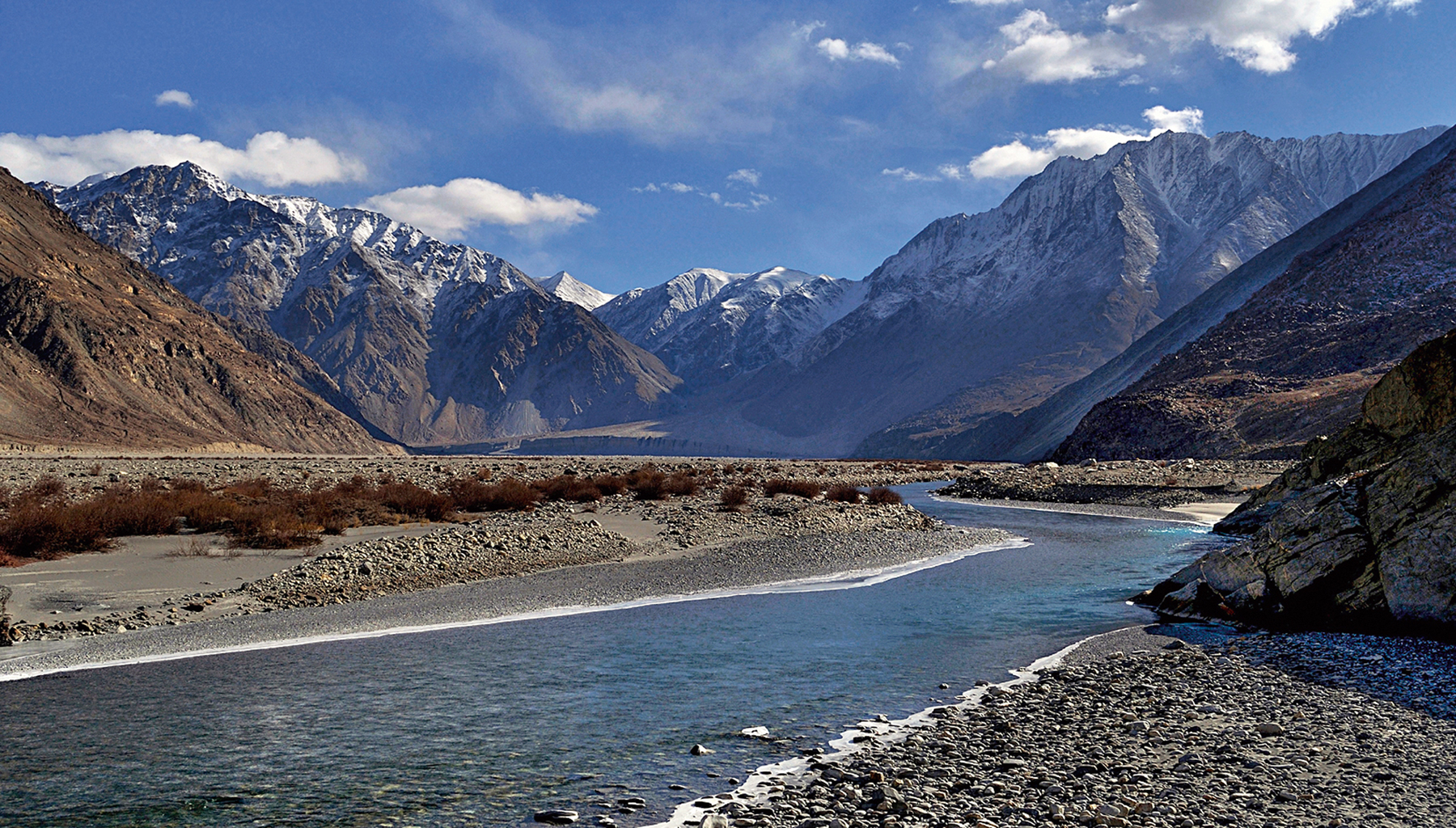 The Shyok river rises in Karakoram and flows towards the northwest. It is fed by the meltwaters of several glaciers and joins the Indus river in northern Pakistan. Photo:Puskar Basu.
The Shyok river rises in Karakoram and flows towards the northwest. It is fed by the meltwaters of several glaciers and joins the Indus river in northern Pakistan. Photo:Puskar Basu.
Glimpse of the Unicorn
It was the nest of a Golden Eagle on the wall of a spiking ridge that motivated me to camp on the banks of Shyok river. I kept a constant vigil the following day, but the raptor evaded me. But the shy herds of kiang, foraging colonies of blue sheep, peeping pikas and encircling Lammergeiers (Bearded Vultures) kept me occupied. On the second day, I approached the cliff by way of a different route. Still no luck! Happy to be alive, I gazed towards what appeared to be another nest. A movement on top of high ground to my right caught my attention. I turned to look at what appeared to be a silhouette of marching swords and a thrill surged through me.
Ancient travelers have narrated experiences of witnessing unicorns in their Tibetan travelogues. We know now that they probably encountered chiru, better known to the world as Tibetan antelopes. Found mainly in the Chinese part of the Tibetan plateau, a small population is sometimes seen in Daulat Beg Oldie (DBO) and the Chang Chenmo valley of Ladakh. In this part of India, they are extremely rare and their population has dwindled to between 250 and 300. They are generally migratory in nature, with males and females forming different migratory herds.
The marching swords soon emerged from the darkness and I instinctively whispered, “chiru…” to no one in particular. It was a herd of males that made a brief appearance on the skyline only to disappear beyond the other side of the ridge. Feeling blessed, I calculated that I had four more days of rations. So, I pitched my tent in the best place I could, hoping to track these incredible, and very elusive mountain goats.
Success! On the following days, I spotted two herds and a solitary female. Oblivious to my presence, she continued to feed nonchalantly and when I approached her, she merely spared me a neglectful look and continued foraging. Chiru inhabit regions where vegetation is unbelievably devoid of adequate nutrients. But these astounding herbivores manage to survive on graminoids, drawing all the moisture they need from the shriveled shrubs. Come winter, they take to digging through the snow to reach these crucial edibles.
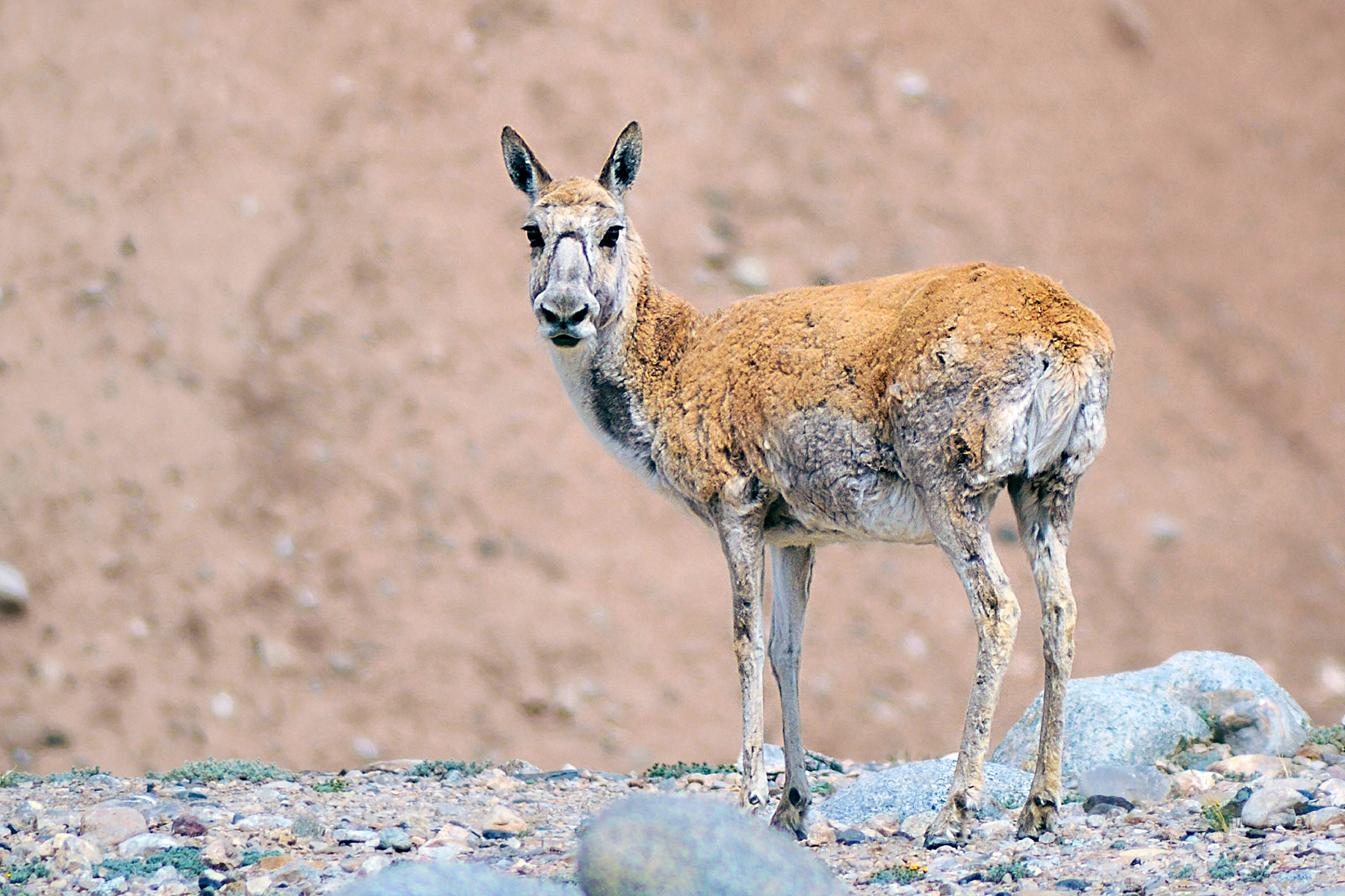 A female chiru looks in the direction of the photographer for a perfect frame. Photo:Puskar Basu
A female chiru looks in the direction of the photographer for a perfect frame. Photo:Puskar Basu
An Enigmatic Migration
The chiru of Shyok lived up to my expectations in the days available to me, but tracking them was a test of patience and fortitude. It was the summer month of July, yet temperatures touched freezing point most times of the day. I was in an austere world and often found myself scrambling along breathlessly on four limbs, while negotiating the spines of formidable ridges.
Since little is known about the stray population of chiru at Ladakh, I had to rely on the research analyses of the migrating pattern of their Tibetan brethren. Chiru migrate across large swathes of land. During autumn, they inhabit the high-altitude desert steppe, which has 30 per cent vegetation cover. Mating takes place in the winter months of November-December, when males challenge each other for mates. Interestingly, they do not use their horns to injure, but merely chase away potential competitors to establish supremacy. Post mating and six months of gestation, calving occurs between late May and early July. With fetuses in their wombs, the females now undertake an epic journey towards remote pastures. Probably one of the most mysterious migrations on earth, unlike that of any other ungulate migration, females team up for a 700 km. round-trip journey. En route they negotiate incessant snowfall, hailstorms, sandstorms, and prolonged starvation, all on top of the colossal physical stress of traversing vast distances while gestating. Predictably, some grow weak, thin and some do not survive the expedition.
In spite of this, chiru follow the same route to reach the same calving grounds… the imperative to undertake the journey etched deep in their genes. The consequences of this painstaking exercise on the newborns are even more devastating. About 40 per cent of newborns die almost immediately after they see the light of the planet and half of the remaining newborns die before they are two months old. The bitter cold that dips below -20°C, the thick snow cover, icy gales and inadequacy of oxygen take their toll, but the species survives this trial of life, despite the fact that the calving grounds have even less vegetative cover… with even more inferior nutrient content.
One reason why chiru undertake this suicidal journey, which reaps no apparent benefits, could be to safeguard newborns from predators, of which the calving grounds have none.
Chiru give birth to a single offspring that will weigh about three to four kg. The young remain weaned to their mothers for a full year, by which time the males begin to grow horns. At the end of 15 months, they are fully grown. Female calves will shadow their mothers for two or three years until they reach sexual maturity.
Calving months vary year to year, depending on environmental conditions. Moreover, the climatic conditions of Ladakh differ marginally from that of the Changtang Nature Reserve. All these minor but significant deviations left me unsure whether the herds I saw were migrating towards the calving ground or returning. On the last day, I got my answer. I saw a month-old calf following its mother along a frozen glaciated slope. The calving would have occurred in May or June. This was possibly a lesser-known sedentary population that travelled a shorter distance. There was little point searching for the calving ground as it would surely have been abandoned by then. Moreover, I was running out of supplies in a valley with zero natural resources for human survival.
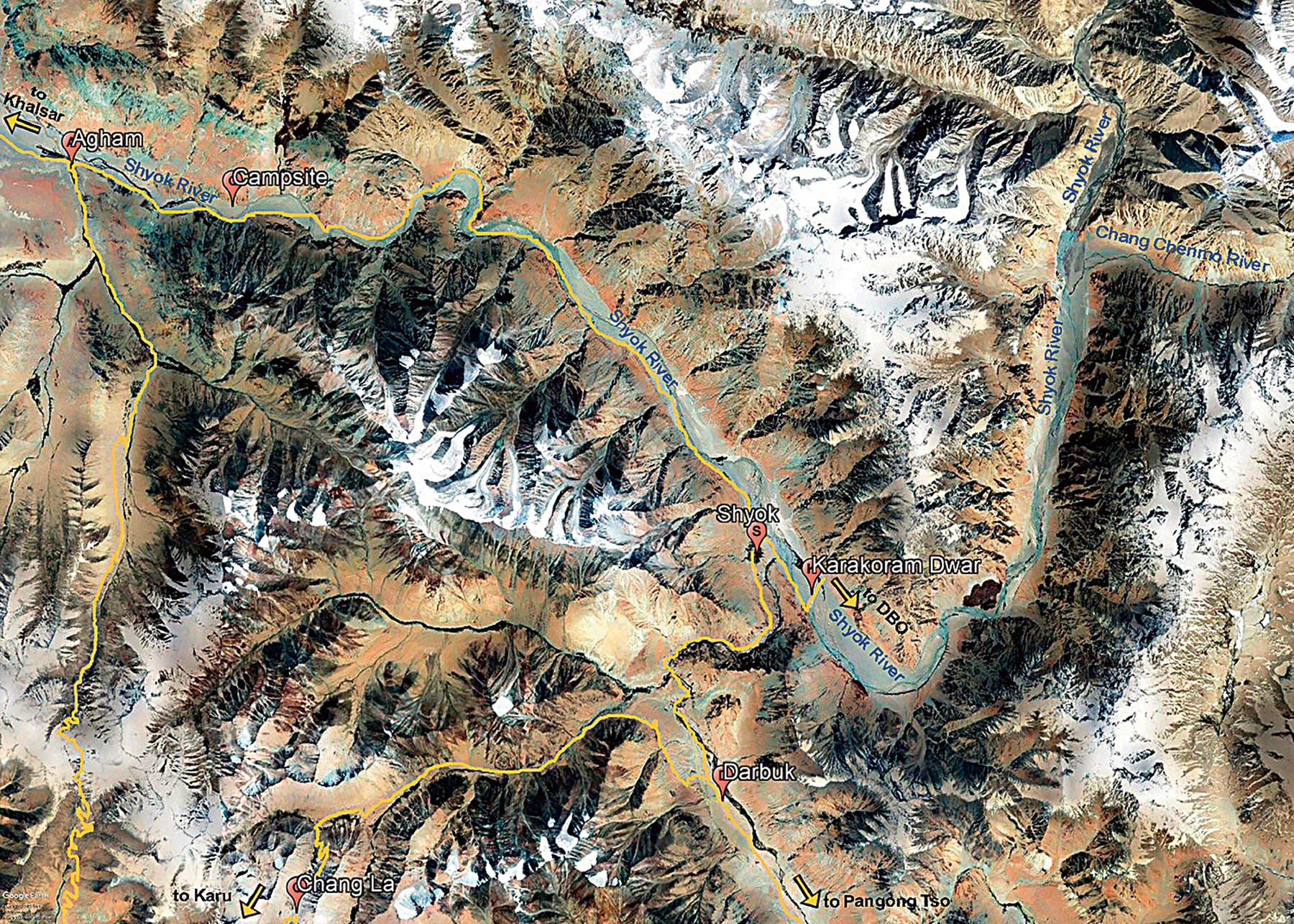 An aerial view map of the craggy peaks at Karakoram. Annual temperatures in Jammu and Kashmir have been surpassing the global average, reiterating the need for India to walk the talk on the climate front to protect its delicate ecosystems. Photo:Puskar Basu
An aerial view map of the craggy peaks at Karakoram. Annual temperatures in Jammu and Kashmir have been surpassing the global average, reiterating the need for India to walk the talk on the climate front to protect its delicate ecosystems. Photo:Puskar Basu
Soft Gold
In the beginning of the 20th century, chiru numbered millions. By the 1990s, almost 95 per cent were wiped out, bringing their numbers down to just about 75,000. Legendary conservation biologist George Schaller estimated that approximately 3,00,000 chiru were massacred in the last decade of the century for the value of their thick fur, the source of the most expensive fabric in the world, called shahtoosh (meaning ‘king of wools’ in Persian). Soft and light, it provides warmth akin to a down feather jacket and is woven into scarves and shawls for well-heeled, but insensitive consumers.
In India, shahtoosh was once considered a prestigious dowry item, but with massive campaigns and enforcement, it now relies on the demand from the west. I find it despicable that consumers are willing to buy their outrageously priced shahtoosh wraps, each claiming the lives of three-five chiru. Their epic and very predictable migration, once a survival strategy, has now become a death sentence at the hands of well-equipped poaching syndicates. The wool is sneaked into Jammu and Kashmir where a particular clan of weavers continues to take pride in manufacturing shahtoosh shawls. Weavers are well regarded in their society, as it is no doubt a skillful if lethal art passed down the generations. I’m told a single, handcrafted, shahtoosh wrap may take years to produce, but that pace has been fast enough to almost wipe the species from the face of the planet.
George Schaller’s lifetime work drew the world’s attention to the lethal shahtoosh trade. The alarming rate of chiru population declines led to their categorisation as Endangered. A ban on shahtoosh trade and even the possession of a shawl was notified by the Convention on the International Trade in Endangered Species (CITES) in 1979. By the turn of the century, we saw tentative improvements and by 2016, estimates suggest that chiru population had risen to between 1,00,000 – 1,50,000.
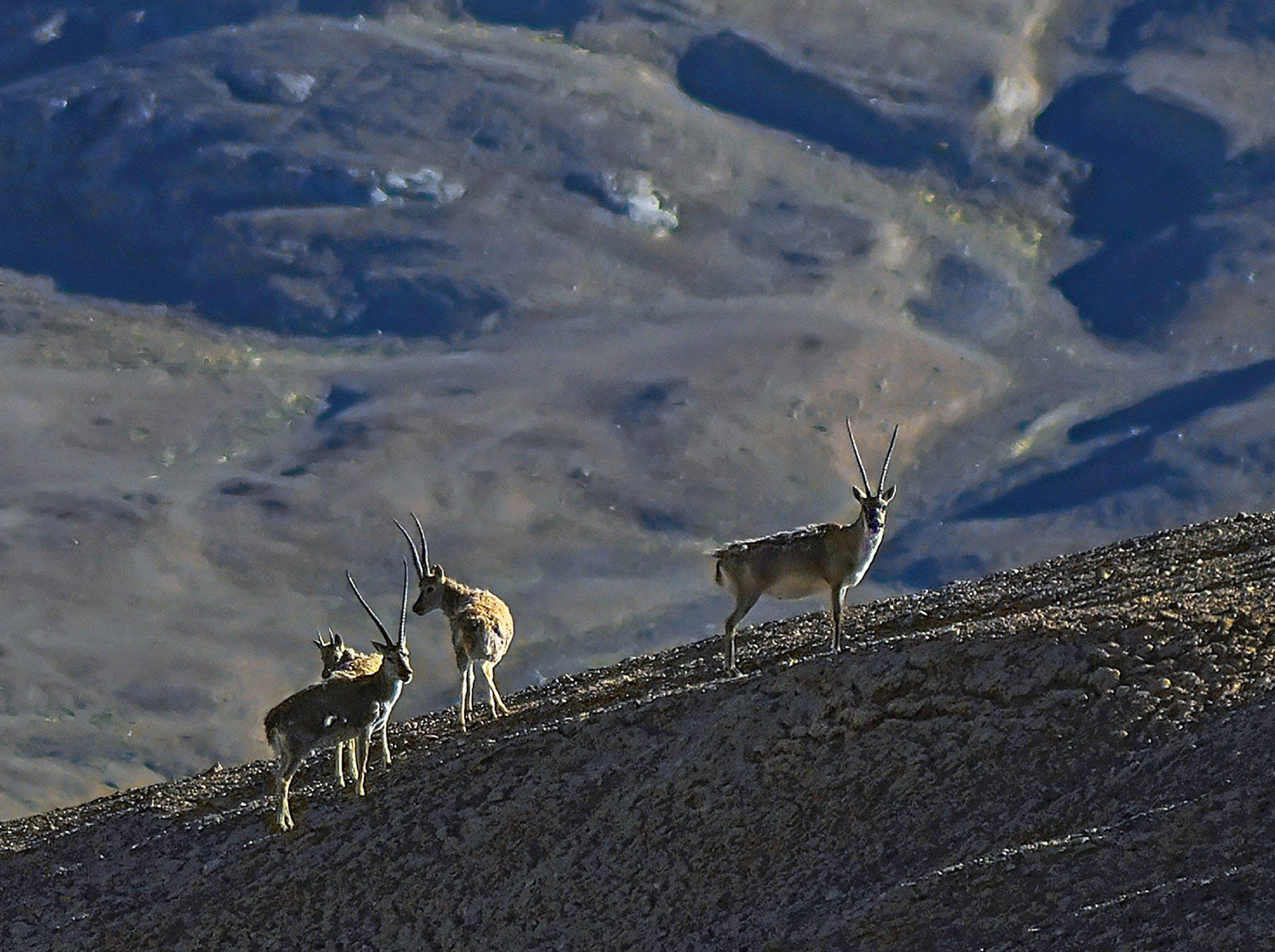 A herd of male chiru pause for a break on a rugged slope. Over the last millennia, chiru numbers have dropped by 95 per cent, owing to poaching and hunting to feed the demand for their fur. Photo:Puskar Basu.
A herd of male chiru pause for a break on a rugged slope. Over the last millennia, chiru numbers have dropped by 95 per cent, owing to poaching and hunting to feed the demand for their fur. Photo:Puskar Basu.
The Future of the Chiru
However, these are mere estimates based on known migratory and sedentary herds clinging to life on the Tibetan plateau. No reliable census was ever conducted on account of the unforgiving terrain and severe weather. Their unpredictable choice of migration routes only made dependable estimates more difficult.
Chiru seem to have hurtled securely down the ages to make their mark in the Karakoram ranges, but their unparalleled adaptation is now suffering a major setback thanks to human self-indulgence. Today the illegal weaving of shahtoosh continues to take a vicious toll on the delicate Tibetan antelope. Of late, the construction and development of roads in prime chiru habitat has added to this threat. What is more, the habitat’s scant vegetation is increasingly being consumed by the domestic livestock of pastoralists.
It was George Schaller’s single-handed effort that drew the attention of the governments of China and India, which resulted in the declaration of the Changtang Nature Reserve in 1993. Subsequently, the Wildlife Conservation Society’s efforts resulted in the notification of the West Kunlun and Shorkul Tibet Antelope Nature Reserve. In India, the newly developed Karakoram Wildlife Sanctuary and Changtang Cold Desert Wildlife Sanctuary will hopefully provide a safe haven to these exquisite mountain dwellers.
The chiru of Ladakh are integral to a landscape that has managed to thrive largely due to minimal human interference. Parts of DBO, Depsang plains and Chang Chenmo valley lie within restricted military zones, and this might just be keeping poachers at bay. Preventing poaching and making shahtoosh wraps objects of derision might just turn weavers away from the golden fleece toward alternate materials from which to make a living. Such possibilities may well raise hopes for the Ladakhi chiru population, but a complete ban on weaving and sale is probably the only way to save the species. Pashmina wool, obtained from domesticated Changthangi goats without killing the animals, offers weavers a very viable alternative, provided we can educate consumers to make the right choices.
When I packed my camp after four days of tracking the near mythical goats, a sweeping sound drew my attention to the sky. It was the Golden Eagle at last, the reason I had ventured into this untraveled wilderness. I smiled, thanking it for its delayed unveiling that had allowed me a glimpse of the mysterious and incredible chiru.
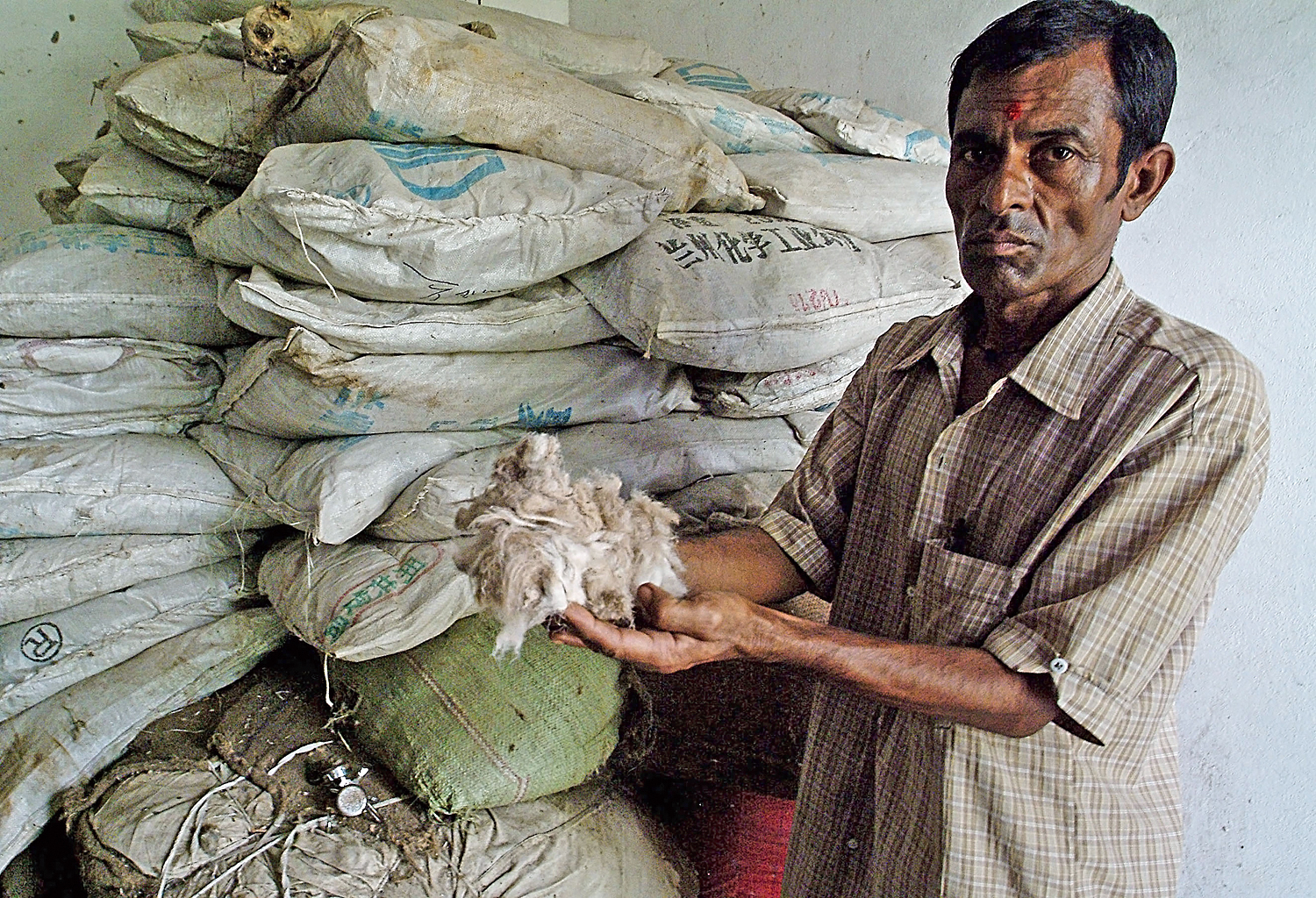 Confiscated fleece, locally called shahtoosh, is illegally used to make scarves. Chiru are now listed under Schedule-1 of the Wildlife (Protection) Act, 1972, under Indian law. Photo Courtesy:Public Domain/Knut-Erik Helle.
Confiscated fleece, locally called shahtoosh, is illegally used to make scarves. Chiru are now listed under Schedule-1 of the Wildlife (Protection) Act, 1972, under Indian law. Photo Courtesy:Public Domain/Knut-Erik Helle.
Adapted to the Mountains
Chiru are the largest mammals that are endemic to the Tibetan plateau. Fewer than 1,50,000 mature individuals are believed to remain in the wild, a majority of which are found exclusively in the Changtang Nature Reserve, in northwest Tibet. These even-toed ungulates are extremely shy. They usually inhabit high mountain treeless steppes and semi-arid deserts above 5,000 masl., where temperatures dip to as low as -400C. They sport a reddish-brown or pale fawn coat with white under-fur. Their woolly under-fur, formed of long guard hairs over short lustrous fibers, is the thickest in the world. Males have long and slender horns with ring-like ridges and pointed tips.
Chiru are specially evolved to negotiate cliffs with great precision. Even a newborn can outrun ponies on the very first day of its life! A full grown chiru can attain a maximum speed of 80 kmph. – an advantage as they need to evade their predators including Tibetan wolves, lynx, brown bear, snow leopards and increasing numbers of feral dogs. The calves are particularly vulnerable to red foxes, sand foxes, Golden Eagles and Lammergeiers. Their light and agile bodies are aptly fuelled with specially designed air sacs within their nostrils, which facilitate increased breathing capacity and greater endurance. They are the only species on earth, which exhibit an extraordinary adaptation – adults retain their fetal version of hemoglobin. This helps hold greater amounts of oxygen in their blood. Their average lifespan is approximately 10-12 years. Because of their inaccessible habitat, very little is known about them. Few animals have been radio-collared but the signals dropped off after a mere three days or less due to the peculiar terrain and tempestuous weather.
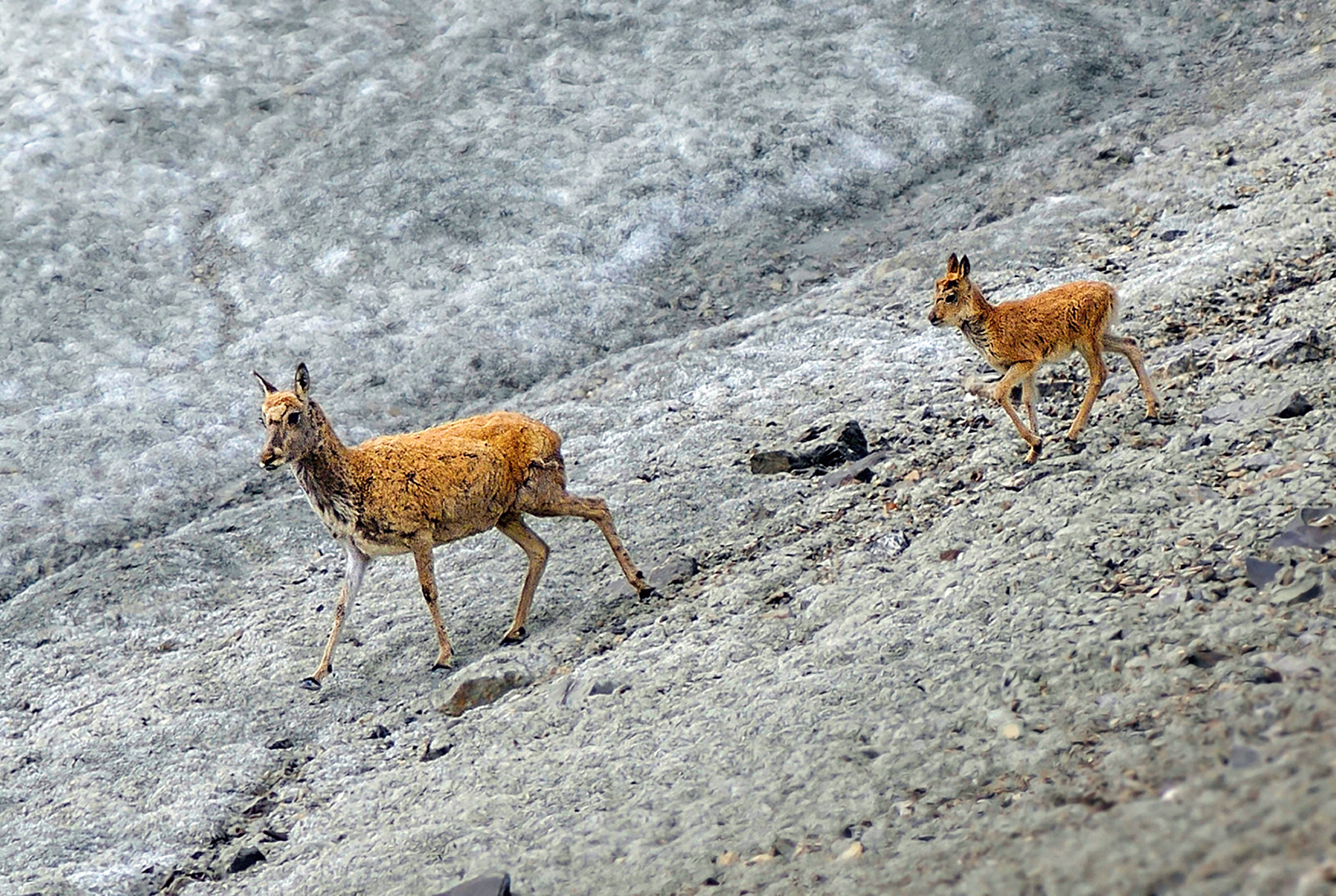 A chiru mother and her calf navigate a steep hillside with unnerving skill. Chiru calves stay weaned to their mothers for upto a whole year, with females staying on for upto three years. Photo:Puskar Basu
A chiru mother and her calf navigate a steep hillside with unnerving skill. Chiru calves stay weaned to their mothers for upto a whole year, with females staying on for upto three years. Photo:Puskar Basu
THE SHAHTOOSH TRAIL
Various countries have recently reported confiscations of shahtoosh. Switzerland alone recorded 295 shahtoosh wraps between 2010-2018, which may have cost the lives of at least 1,180 chiru. Other countries have recorded confiscation of shahtoosh worth 800 chiru between 2015-2018. In India, 35 shahtoosh were seized in 2018, which confirms the killing of at least 140 animals. These are mere statistics, however. The quantities which escape vigilant officials are possibly far more than what was seized.
The identification of shahtoosh is getting difficult. Earlier it was identified by the presence of few guard hairs, which are extremely cumbersome for weavers to remove. However, in recent days, weavers mix shahtoosh with pashmina, making it difficult to discern. Another identifying procedure was to pass it through a wedding ring. Earlier only a shahtoosh would have passed this test. But nowadays pashmina and many other fabrics can be softened with chemicals and can pass the test. Tracing weavers is difficult, as most masquerade as pashmina manufacturers. Conventional anti-poaching patrols in this unforgiving terrain is also a farfetched reality. Given the above data, current chiru population needs to be re-evaluated.
A passionate wildlife photographer, national level swimmer and mountaineer, Puskar Basu's affinity for nature and adventure attracts him to inaccessible wildlife refuges to document lesser-known species.
First published in Sanctuary Asia, February 2021.

.png)





